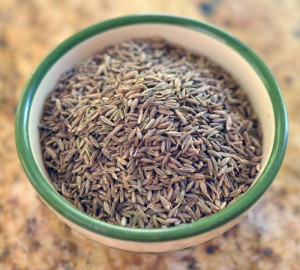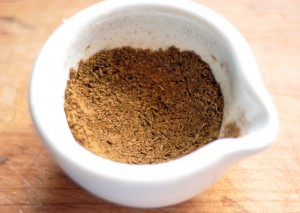Cumin, my first spicy crush
 When I was 12 I had a mad crush on Carey Reynolds. He was a family friend and had come to a dance party in our basement on Long Island and spent the night at our house. He left his sport coat in my brother’s closet. For days after, I would sneak into my brother’s closet and inhale his jacket. The sent of him would put me back in the basement, in his arms, awkwardly moving to In the Still of the Night. The fragrance of cumin is as evocative of time and place for me as that first spicy crush. (I think Carey later became a Catholic priest so I must not have made much of an impression.)
When I was 12 I had a mad crush on Carey Reynolds. He was a family friend and had come to a dance party in our basement on Long Island and spent the night at our house. He left his sport coat in my brother’s closet. For days after, I would sneak into my brother’s closet and inhale his jacket. The sent of him would put me back in the basement, in his arms, awkwardly moving to In the Still of the Night. The fragrance of cumin is as evocative of time and place for me as that first spicy crush. (I think Carey later became a Catholic priest so I must not have made much of an impression.)
Growing up, my Dad, a chef in his own restaurant, was not often home for dinner. On the rare occasion he was at home on a hot summer night the meal I craved was Lamb Shish Kebab grilled over a charcoal fire. My father had this coffee can tower contraption he used to get the coals perfectly hot for grilling. The meat and vegetables would have been marinating for at least a few hours. I would help skewer the kebobs then run around the backyard trying to catch lightening bugs while taking in the dizzying scent of cumin.
I couldn’t name the nutty, earthy, exotic fragrance drifting from the sizzling meat but it didn’t matter. The perfectly cooked cubes of lamb, peppers and onions served alongside Greek Pilaf with toasted pine nuts and raisins… it was a child foodie piece of heaven. There are other delicious dishes from the family repertoire of Greek recipes I grew up on, but Shish Kebab is where my love of cumin, began.
Cumin is an ancient spice believed to have come from Egypt. It is mentioned in the Bible (I’ve read, I’m no expert on the Bible) and was revered by the Romans. Today, it is cultivated primarily in India, Morocco, Turkey and Iran and is a principal flavor in those cuisines as well as Greece and Lebanon, Mexico, Cuba and Puerto Rico.
Recently, in Istanbul, we ate cumin everyday on roast fish and meats and in vegetables stewed with tomatoes. Our favorite local Lebanese restaurant, Fairuz in Marylebone, London makes a spinach dish Ernie devours that uses lots of cumin. And then there are Indian curries, Mexican chili, Egyptian dukkah, a popular street vendors dip for bread with olive oil, and Moroccan couscous. The whole seeds are best toasted in a dry pan then used whole or ground with a mortar and pestle. The bitter yet sweet flavor of cumin pairs especially well with coriander which is a bit lighter and more citrusy.
 To buy and store: ideally, buy whole seeds and toast and grind as needed. That said, I do keep a jar of ground cumin when there’s no time to toast and grind or when you’re using tablespoonfuls as I might.
To buy and store: ideally, buy whole seeds and toast and grind as needed. That said, I do keep a jar of ground cumin when there’s no time to toast and grind or when you’re using tablespoonfuls as I might.
Keep stored in tightly capped jar. I buy the small round light brown seeds which can also have lemon notes. I’ve never tried the oval-shaped greenish-yellow seeds that apparently taste a bit grassy. I need to find some. Don’t buy too much. All spices lose flavor over time. Find a spice vendor who has lots of turnover. In London I go to The Spice Shop off Portobello Road.
Some ideas to play with:
- Try toasting and grinding the cumin and coriander and make a paste with olive oil and salt and pepper to coat salmon or chicken.
- Liberally dust sweet potatoes with ground cumin, coriander, paprika and cayenne and toss in olive oil this might work with carrots or parsnips although I haven’t tried it.
- Saute ground cumin in olive oil with onion and garlic, add fresh spinach, lots of lemon, chick peas, tomato and Lebanese sumac for a totally delicious vegetable side dish
- Add cumin to a vinaigrette made with lime or orange juice, olive oil, red wine vinegar and salt and pepper to taste.
- Roast with cauliflower; cut cauliflower into small florets, toss with live oil and sprinkle cumin and salt and roast at 180C for about 30 minutes.
- Egyptian dukkah- cumin, coriander, chopped hazlenuts (pistachios should work too), sesame seeds, salt and pepper. Dip bread in olive oil then the dukkah mix.
- Dhal- there are so many good recipes for dhal. Basically you soak the dhal (real dhal is harder than lentils which are often used; regular split peas don’t need to be soaked) and then bring to a simmer with two times the water. Add 1-2 tablespoons chopped, fresh ginger, 1 tablespoon ground cumin, ½ teaspoon turmeric and I like to add something hot- cayenne or chili. Just before serving saute some onion with whole cumin seeds and a little garam masala. Add to the dhal mixture and yum!
Little known superstition- cumin keeps chickens and lovers from roaming; not sure how that works in reverse.






